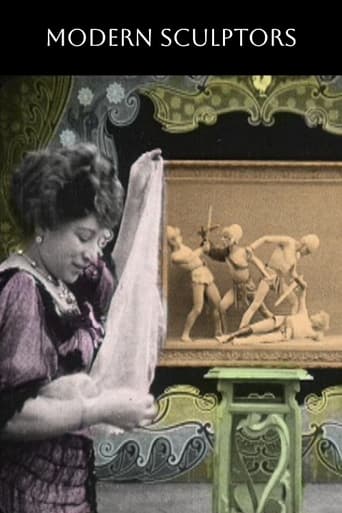



Why so much hype?
It really made me laugh, but for some moments I was tearing up because I could relate so much.
View MoreVery good movie overall, highly recommended. Most of the negative reviews don't have any merit and are all pollitically based. Give this movie a chance at least, and it might give you a different perspective.
View MoreIt really made me laugh, but for some moments I was tearing up because I could relate so much.
View MoreThis film HAS to be the first use of clay animation. While most people think this technique came later, in the fifties, with Art Clokey's "Gumbasia" and their Gumby cartoons, I think what is shown here can be considered clay animation. It's done very well for 1908 and still looks good today.Julienne Mathieu, who starred in director Segundo de Chomon's other works, also appears in this one. She apparently plays a lady who puts on an art show. First, she presents a series of marble statues which come to life even though they're miniatures. Then some moving paintings. None of this is very gimmicky until the woman presents to us some blocks of clay that, unaided, mold and shape themselves into clay statues. Some of these clay renderings are an alligator, an eagle, mice on a shoe, etc. Later, she even brings one of them, a washerwoman, to life! Despite lack of plot, it's new and different from Georges Melies's work, who by the time it was made had changed paces and was trying to meet the needs of audiences by making comedies. And, while this is a trick film, it is a lot more up-to-date than Melies, with cutting to closeup shots to show the art.
View More"Modern Sculptors" is a terrific example of a film which has exceptional special effects but they were not utilized well because the film was so rushed and the style was a bit dated. Segundo de Chomón began copying the styles (and occasionally the films themselves) of his rival, Georges Méliès. In a few cases, he even improved on the old master's camera tricks--like he does here. But style-wise, the film could have used some help.A woman (Julienne Mathieu--the director's wife) runs some sort of sculpture gallery. She shows off her statues to the audience and some of these marble pieces of art move (using double-exposures of actors painted white like statues). Then, she shows off lumps of clay that form themselves into wonderful or humorous pieces of art. This final portion of the film was by far the best.So what's wrong with the style? Well, the entire thing was done in a very stagy manner--and confined everything to a very small space. Having the woman walking about in a store versus standing almost stationary on a small set would have improved things a lot. Also, this case is a great example where more is actually less. So many pieces of art are presented so quickly, that there is no artistry or flair--they just bombard the audience. Adding at least five minutes and introducing them slowing OR eliminating some of the art would have made for a better film. It is interesting and worth seeing--but it's a shame such nice effects weren't utilized better.
View MoreDespite the impressive use of stop-motion camera-work here, trick films like this were beginning to look a little dated back in 1908 simply because they failed to tell a story - which more and more films were beginning to do. Filmgoers were no longer astounded by the sheer fact of a film's existence and the simple tricks that could be performed with a camera, and were looking for something a little more sophisticated.Segundo de Chomon is largely forgotten today, but in his time he was a rival to the infinitely more famous Georges Melies. He crafts quite an interesting film here which starts slowly with a lady presenting various sculptures and paintings in which the figures assume different poses. Things improve when we are shown moving figures created out of mounds of clay - mice on a boot, an eagle, a crooked old lady who turns into a real person before being once again transformed into a clay figure. It all seems fairly rudimentary in these days of CGI effects, but it still manages to retain an element of wonder.
View More